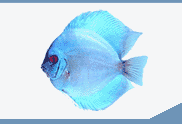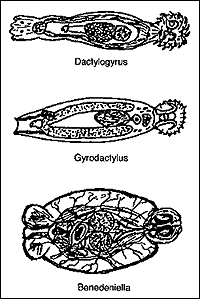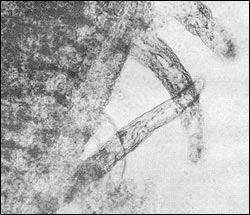

 |
||||||||||||
 |
||||||||||||
| Monogenean Trematodes | ||||||
| Peggy Reed, Ruth Francis-Floyd, and Ruth Ellen Klinger | ||||||
Monogenean trematodes (flukes) are a group of parasites best described as flatworms. Monogeneans are commonly found on the gills, skin or fins of fishes and lower aquatic invertebrates. A few may invade the rectal cavity, ureters, body cavity and even the blood vascular system. There are more than 100 families of monogenean trematodes found on fishes of the world, in fresh and salt water, and at a variety of temperatures.  Figure 1: Most monogeneans are browsers, moving about the body surfaces, and feeding on dermal (skin) mucus and gill debris. Monogeneans have a series of hooks that enable them to attach while feeding ( Figure 1 ). Most species are host- and site-specific, requiring only one host to complete an entire life cycle. In fact, some adults will remain permanently attached to a single site on the host.
Figure 1: Most monogeneans are browsers, moving about the body surfaces, and feeding on dermal (skin) mucus and gill debris. Monogeneans have a series of hooks that enable them to attach while feeding ( Figure 1 ). Most species are host- and site-specific, requiring only one host to complete an entire life cycle. In fact, some adults will remain permanently attached to a single site on the host.
Morbidity and mortality epidemics in cultured fish caused by excessive parasite loads are associated with crowding, inadequate sanitation and deterioration of water quality. Although monogeneans are commonly found on wild fish, they are rarely a direct cause of disease or death in free-ranging populations. Dactylogyrus is usually attached to the gills of freshwater fish. It reproduces by laying eggs often resistant to chemical treatment; therefore, weekly treatment over a period of 3--4 weeks is recommended. Gyrodactylus is usually found on the skin and fins of freshwater fish, it produces live young, and one treatment may be adequate to control an infestation. Benedeniella is a large monogene which can cause chronic problems in marine systems and is difficult to eliminate from a system once established. See Figure 1 . CLINICAL SIGNS AND EFFECTS Freshwater fish infested with skin-inhabiting flukes become lethargic, swim near the surface, seek the sides of the pond and their appetite dwindles. They may be seen rubbing the bottom or sides of the holding facility (flashing). The skin where the flukes are attached show areas of scale loss and may ooze a pinkish serous fluid.  Figure 2: Heavy gill infestations ( Figure 2 ) result in respiratory disease. Gills may be swollen and pale, respiration rate may be increased, and fish will be less tolerant of low oxygen conditions. "Piping", gulping air at the water surface, may be observed in severe respiratory distress. Large numbers of monogeneans on either the skin or gills may result in significant damage and mortality. Secondary infection by bacteria and fungus is common on tissue which has been damaged by monogeneans.
Figure 2: Heavy gill infestations ( Figure 2 ) result in respiratory disease. Gills may be swollen and pale, respiration rate may be increased, and fish will be less tolerant of low oxygen conditions. "Piping", gulping air at the water surface, may be observed in severe respiratory distress. Large numbers of monogeneans on either the skin or gills may result in significant damage and mortality. Secondary infection by bacteria and fungus is common on tissue which has been damaged by monogeneans.
In salt water fish, sharks, skates and rays, the monogenean, Neobenedinia spp., may infest the skin and gills, resulting in extreme irritation to the host. Sharks with a heavy infestation show early manifestations of erratic swimming, flashing and rubbing on the bottom of the tank. Gray patches and open wounds may appear on the skin. Ulcerated skin lesions are susceptible to secondary bacterial infections, which may result in mortality. Affected gills may become irritated, hemorrhaged and swollen. Sand grains may stick to the gills as infested sharks suck in sand in an attempt to rub off the parasites. more ... |
 |
|||||
| About Us :: Message Board :: Chat | |||||
| Library :: Photo Gallery :: Links & Resources :: Breeders & Sponsors :: Merchandise | |||||
| Website designed by: EthanCote.com | © 2001-2004, SimplyDiscus.com. All Rights Reserved. | ||||